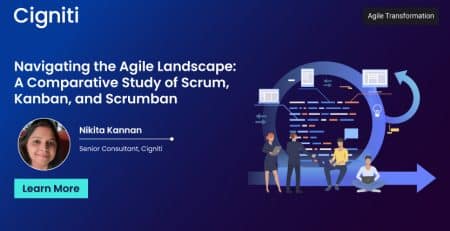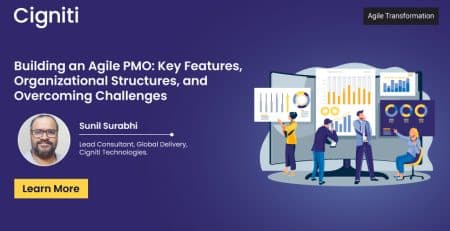Embracing Agile at Scale: Navigating the Evolution of Agile in Large Enterprises
The heightened demand for agile scaling across enterprises in contemporary times is underscored by several key factors, including the rapid pace of product changes within organizations, evolving customer expectations and market dynamics, the imperative of digital transformation and innovation, the risks associated with falling behind in competition, the inherent advantages of adopting agile methodologies, and the pressing need to adapt or face the consequences of obsolescence.
Some of the most experienced hurdles in this journey are Lack of cross-team coordination, Ineffective communication and information flow, Difficulty in managing change, Slow time-to-market, Reduced flexibility and adaptability, Lower employee engagement and satisfaction, and Increased risk of project failures.
All the above hurdles have encouraged organizations to explore scaled Agile frameworks as a strategic solution to overcome these obstacles.
The transformative power of scaling Agile addresses these challenges, promoting collaboration, faster time-to-market, and improved overall efficiency by Fostering cross-team collaboration, Streamlining communication and information flow, Agile Change Management, Accelerating time-to-market, Enhancing flexibility and adaptability, Boosting employee engagement and satisfaction and Mitigating project risks and failures.
Choosing the proper Agile scaling framework for an organization is a critical decision that requires careful consideration of its unique needs, culture, and goals.
Here are insights into how organizations can navigate this decision-making process:
- Understand Organizational Goals and Objectives
- Assess Organizational Culture
- Consider Organizational Size and Complexity
- Evaluate Existing Agile Maturity
- Consider Regulatory and Compliance Requirements
- Evaluate Framework Flexibility
- Assess the Fit with Team Structure
- Evaluate Industry Best Practices
- Pilot and Experiment
- Seek Expert Guidance
Remember that choosing an Agile scaling framework is not a one-size-fits-all decision. Organizations may need to tailor and customize the chosen framework to fit their unique context. Regular retrospectives and feedback loops can also help continuously improve and refine the selected framework’s implementation over time.
Choosing the Right Framework:
Indeed, several popular Agile scaling frameworks have emerged to help organizations scale Agile principles and practices to large teams and complex projects. Here’s an overview of some of the prominent frameworks: SAFe (Scaled Agile Framework) and LeSS (Large Scale Scrum)
SAFe (Scaled Agile Framework):
Overview: SAFe is one of the most widely adopted Agile scaling frameworks. It provides a comprehensive set of principles, practices, and roles to scale Agile from individual teams to large enterprises. SAFe is based on Lean and Agile principles and includes various configurations to suit organizational needs.
Key Components:
SAFe Big Picture: A visual representation of the SAFe framework, illustrating the roles, activities, and artifacts at different levels.
Agile Release Train (ART): A team working together to deliver value in a value stream.
PI (Program Increment): A time-boxed planning interval during which an Agile Release Train delivers incremental value.
SAFe Roles: Includes roles such as Release Train Engineer (RTE), Product Owner, Scrum Master, and others.
SAFe Configurations:
- SAFe Full
- SAFe for Portfolio
- SAFe for Large Solution
- Essential SAFe (for smaller organizations)
LeSS (Large Scale Scrum):
Overview: LeSS is an Agile scaling framework that extends Scrum to multiple teams. It focuses on simplicity and aims to retain the core principles of Scrum while scaling up. LeSS emphasizes feature teams, which are cross-functional teams that work on a single product backlog.
Key Components:
Product Owner Teams: A single Product Owner is responsible for the product backlog, and teams work together on a standard product.
Area Product Owners: Collaborate with the Product Owner to manage the product backlog for a specific area.
Scrum of Scrums: Regular events where representatives from each team coordinate and discuss dependencies.
LeSS Huge: An extension of LeSS for larger organizations with multiple feature teams.
Principles:
More with LeSS: Focus on simplifying, removing unnecessary elements, and embracing Scrum principles.
Whole-Product Focus: Teams work on a single product, not just individual components.
It’s important to note that the choice of an Agile scaling framework depends on various factors, including the organization’s size, structure, culture, and specific requirements. Some organizations may combine elements from different frameworks to create a customized solution that best fits their needs. Each framework has strengths and considerations, and organizations often tailor them to suit their unique contexts.
In scaled Agile environments, effective collaboration, communication, and transparency are essential for the success of large and complex projects. Modern tools and technologies play a crucial role in supporting these aspects. Some tools and technologies facilitate collaboration, communication, and transparency in scaled Agile environments.
Agile Project Management Tools
These tools provide features for backlog management, sprint planning, and tracking progress. They facilitate collaboration among teams and help visualize work items and priorities.
- Collaboration Platforms
- Video Conferencing Tools
- Integration Platforms
- Virtual Whiteboarding Tools
- DevOps and Continuous Integration Tools
- Version Control Systems
- Agile Analytics and Metrics Tools
- Road mapping Tools
- Agile Testing Tools
- Knowledge Management Systems
- Real-time Dashboards and Reporting Tools
Choosing the right combination of tools depends on the specific needs and preferences of the organization. Integration between these tools is often crucial to creating a cohesive and collaborative environment in scaled Agile settings. Regularly reassessing and updating the toolset to align with evolving requirements is also essential for sustained success.
The positive impact of scaling Agile on organizational adaptability, innovation, and customer satisfaction can be achieved as a transformative agent, which includes but is not limited to Unleashing organizational adaptability, Fueling innovation at scale, Elevating customer satisfaction, Streamlining communication and collaboration, Faster Time-to-Market, Enhanced product quality, and Employee engagement and satisfaction.
Conclusion
With all the above, we can infer that it reinforces the idea that Agile scaling is not a one-size-fits-all approach and requires continuous evaluation and adaptation. This will encourage organizations to view Agile scaling as a strategic advantage in a dynamic business landscape. The scaling involves a mindset of transparency and good collaboration, too. These can be achieved using the appropriate tools for better agile scaling management.
Need help? Contact our Agile Transformation experts to learn more about embracing Agile at scale and implementing in large enterprises.





Leave a Reply